The Moving Targets Skill Theme pt 2
VANILLA SECRET 3 & BUTTER BRIDGE 1
Vanilla Secret 3 and Butter Bridge represent two of what I call �variations� on the theme of moving targets. I liken these two levels to a fantasia and a toccata. A fantasia generally means that a music composer�or, in our case, a game designer�creates something that�s based around spontaneity and improvisation. Of course, this is not the norm in classical music or game design. Well-designed games have a lot of room for a variety of techniques, but if the game, section or level is designed too loosely, it�s easy for players to miss the challenge and the fun. (There are a few exceptions, naturally.) In Vanilla Secret 3, however, the designers just decided to throw some things together with only loose organization and let the player sort it out.
There are some ordinary, cycling platforms that stay in place in this level. That, however, is not the fun part. What you see on the right is these waves of dolphins that move in a kind of sine wave shape across the screen. These platforms are so clustered it�s that there�s no clear optimal path. Instead, the player has to improvise.
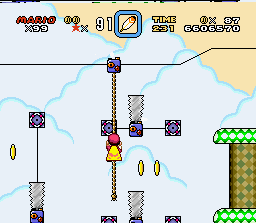
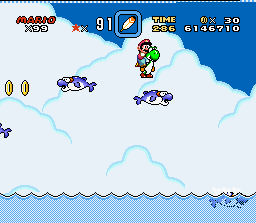
There�s also barely any penalty. The puffer fish which lurks in the water is technically dangerous but it�s easy to avoid even in the water. Then of course there�s all the water; this takes the penalty out of the jumps in the same way it did in the early Yoshi�s Island levels. Falling has only a small risk of damage, and little risk of dying. This level is also one of the shortest in the game, in terms of the number of identifiable challenges. There�s not a whole lot between Mario and the end-goal, except a lot of room to improvise.
Sticking with the musical metaphor for a moment, we examine the level which is more like a toccata: Butter Bridge 1. A toccata is a musical piece designed to show off an instrumentalist�s skill. A toccata can be beautiful, but the first goal of such a piece is to allow the performer to display technical skill in flashy, obvious ways. (Subtle flourishes may also be included, but they aren�t the point.) In order to achieve this sense of flashiness the toccata often will include things that are obviously difficult, unusual, and sustained. This is the perfect description of Butter Bridge 1.
The first thing the player will notice about Butter Bridge 1 is that the scrolling camera controls the pace of the level. This makes it easy for the designers to force waiting periods and precisely timed jumps, which fit with the current skill theme. What it does not do, however, is make this process easy. The slowly-scrolling camera forces the player to wait, but the tipping-scale platforms in this level make waiting deadly. And this is to say nothing of the fact that all of them have a width of only two blocks.
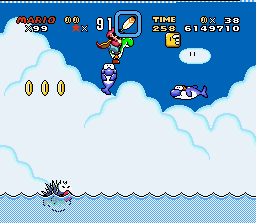
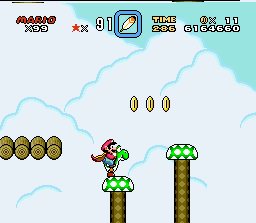
The platforms sink at a rake of about one coin-block per 15 frames, with a corresponding rise in the platform which makes up the other end of the scale. The tricky part about this is that not only does the filled platform sink, but the opposite platform rises, meaning that for every 15 frames that Mario occupies one of these platforms, the delta-height of the next jump increases by two. Considering that the camera may not always reveal the platform yet to come, this configuration can quickly put Mario in a position he cannot escape. When not occupied, the platforms will return to an even position, but at a rate of about 40 frames per 1 coin-block�much slower than the damage is done (although if the platform has sunk less than 1/10 of a block, it seems to reset more quickly).
The tipping-scale platforms are unique in Super Mario World, but are not the level�s only curiosity. At a larger structural level, we encounter another bit of strangeness which fits the toccata metaphor: most of the challenges in this level come in an unbroken chain. Whereas a typical level breaks up its expansions and evolutions with empty platforms, punctuating challenges, or even crossover challenges, Butter Bridge 1 simply puts all of its challenges in a row, such as this monster:
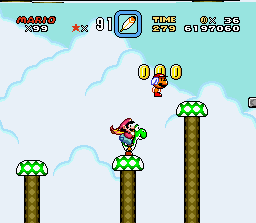
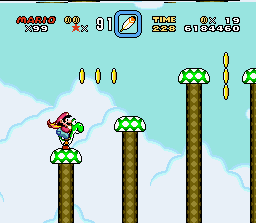
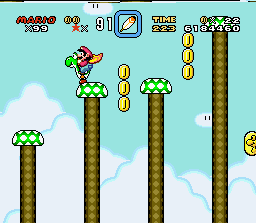
The difference in height means this is an expansion. The fact that the player has no break seems like it should be an evolution�but this is one place in the game where this classification system falls down. This part of the level doesn�t look or act like anything else in the game, really. And the sustained action makes the level seem considerably harder than it really is; all the player really needs to do is repeatedly jump and cape-glide back down without changing platforms. The platforms� return to equilibrium is not fast enough to preserve equilibrium indefinitely, but a player constantly jumping and gliding back down will avoid problems. Jumping between the two platforms while gliding can accomplish this even better, while waiting for the screen to scroll. As noted, though, the level gets much easier after a few playthroughs. This is where the toccata comparison is most telling. A toccata displays the performer�s talent by sustaining odd and challenging musical passages at unusual length. This, Butter Bridge 1 does. What Butter Bridge does not do, however, is impress an audience. After a few playthroughs, the player will master the skills for the level and it will be easy; it will also look easy. After all, the d-distances between platforms are rarely more than 3 blocks. There are occasional periodic enemies patrolling between jumps, but they often make the jumps easier, because the player can bounce Mario off of them, shortening the only two jumps in the level that are wider-than-normal expansions. There�s nothing visually impressive about it, for all its initial acrobatic terror.
Although many of us who have played this level remember it for the second-by-second frustration it gave us, Butter Bridge 1 is one of the shortest levels in the game by total lateral distance, and none of the jumps are particularly far in either direction, if the tipping scale mechanic is handled correctly. Mastery of this level, however, looks and feels impressive even to the player who has realized just how easy it really is. A good game cannot always tell players how much they have to learn; sometimes it�s necessary for the game to tell them how far they have come.
FOREST SECRET AREA
Forest Secret Area doesn't do that much in the way of a cadence although it�s very clearly a moving targets level. What's here is cleverly organized along thematic lines, just not in a real cadence�but the themes are so stunningly clear here that it almost justifies the lack. The only problem is that it's way too easy for the player to break that organization and never see the thematic appropriateness behind it. You might say that this level is art for the artist�s sake, which is always a questionable decision. Nevertheless, there�s a lot to learn from it as long as we�re studying game design. The level contains two platforms at the beginning: front and back. The choice of platforms gives the player subtly different experiences, assuming the player rides only one for the whole way to the goal. The front platform will take Mario through a series of lateral encounters with intercepts with an emphasis on action solutions. In these two spots pictured below, the approaching Wing Koopas will almost pin Mario down beneath the coin-blocks, making his jump haphazard or simply interrupted.
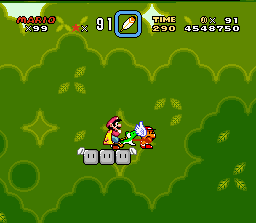
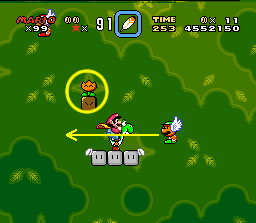
The easiest solution to this is to use fireballs to knock out the oncoming Wing Koopas in one shot, and coincidentally enough this path takes Mario past a block which will grant one. The thematic material is obvious: this is the intercepts theme at its most action-oriented. I can�t see why this is plugged into a moving targets level where it�s so easily overlooked, but the designers took a risk here and it didn�t go horribly, at least.
The back platform, if ridden the whole way, will still encounter intercepts, but will emphasize jumping solutions and provides a feather powerup. Note that I call them intercepts because the player is, in a sense, in a continuous jump as the platform moves up and down. The effect isn�t particularly challenging, but it does simulate intercept-like situations, even if the enemies don�t fit the strictest definition.
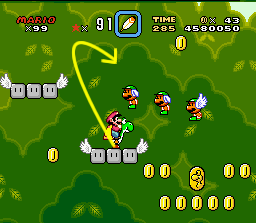
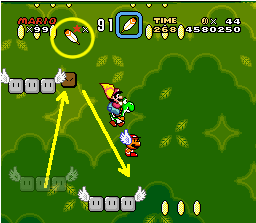
You can see how, as the platform rises into these Koopas, Mario is forced into an off-platform jump and glide, most likely a back-jump and possibly an enemy bounce. In the first case, the period of the enemies is essentially non-existent (if they turn around, it happens off-screen), but their quantity forces Mario to jump somewhere clear of them: off the platform. The second challenge is a kind of insidious mutation of this: there's only one Wing Koopa but he's on a very short patrol and so has a similar effect.
Both platforms take Mario through this L-shaped intercept trap, but their approach angles make a lot of difference. The fire-flower path takes Mario up into them, revealing the three laterally-flying Wing Koopas first, and offering a clear shot at them with fireballs.

The feather platform path brings Mario in from overhead, offering a shot at jumping on the vertical Wing Koopa before descending with a glide onto (or past) the other three.
The thematic material in this level is delivered so elegantly, so it's a shame that the level's two-platform style makes it so the player will probably never perceive this elegance. The intersections of the platform can�t help but suggest a transfer from one platform to another. After all, most of the game's content is delivered as Mario hopping from one platform to another. But only by ignoring this impulse (and perhaps playing the level twice in sequence) can the player actually get the most coherent experience of the level. It�s just not likely.
ROY'S CASTLE
Roy�s Castle is an interesting take on the tracked content idea from the two bridge levels the player has faced so far. Like Butter Bridge, this level is actually quite short, but because it introduces a mechanic not yet seen in the game, it seems much more difficult at first than it really is. Mario is forced to ride what might be called a caterpillar platform. The platform moves, but does not carry Mario with it, so the player needs to constantly walk Mario along the length of it in order to stay above the lava below. The challenge lies in the fact that this platform takes many different shapes, and moves in many different directions. The unpredictability of the first few attempts makes it seem hard�but ultimately there are only really 4 challenges while on the caterpillar platform, and none of them are particularly complex.
Before we examine the challenges individually, however, it�s important to point out three level-wide design considerations. Most of the d-distance for this level is over lava, and so most of the missed jumps will be fatal. There�s also no mid-gate, so all failures will result in the player having to completely re-attempt the level. Finally, there�s a very important shift in skills that�s taking place in this level. Up until now, the core skill of the moving targets theme has been the timing jump. That�s still true. But before Roy�s Castle, this skill was typically supported by the cape-glide and the back-jump (sometimes both together). In other words, players could afford to make more mistakes than they can in this castle, because skilled use of the cape could allow players to recover. Since Cheese Bridge, that recovery has been getting harder and harder, and now this castle completely negates that ability, because the caterpillar platform travels very quickly and often in erratic paths. Cape gliding will only result in a stranded, doomed Mario slowly gliding into lava. Back-jumping is basically impossible unless the player has the platform�s path completely memorized, and if that�s the case, why do they need a back-jump at all? What replaces these skills is the controlled-height jump, which is going to feature more and more prominently as the moving targets theme (and the game as a whole) reaches its climax.
The first challenge sees the platform contract and change shape, taking the form of a staircase. The difficulty lies in the fact that until this challenge the platform had moved in a quick but mostly straight path so that Mario could just walk. Simply walking with the platform is the standard challenge for the level. Now, though, Mario has to jump, although he is faced with two complications. The first complication is that the bottom step of these stairs is always disappearing because of the platform�s constant movement. The second complication is that because of the stair shape, half the platform�s width is now of no use to him. Essentially, the platform has gotten smaller and changed shape, forcing a timed jump.
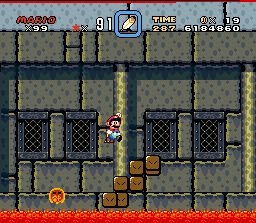
The next challenge is different, and involves no jumping, but is still tricky. The platform bends around several times.
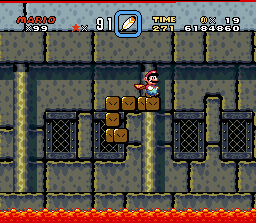
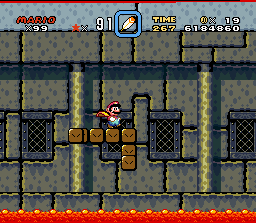
In this case, the player is being tempted to simply overrun the platform. The platform will extend 11 blocks straight out�a distance that the player is intuitively used to by now. The player will be tempted to go into a full run on those 11 blocks, but the platform turns immediately downward resulting in a pitfall. What the designers are doing here is to manipulate the player�s most important skill in this skill theme: prediction. The timing jump�the core skill of this theme�involves predicting regular motion. This platform, unlike all that have come before it, is not regular in the same sense the others have been. The skill betrays the player, until a few deaths have made him or her cautious.
Next we see another staircase challenge, although a bit longer. This staircase comes with a typical evolution challenge: add a periodic enemy to a timed jump. These four bouncing fireballs are almost an intercept, in that they cause the player to modify Mario�s jump-path. But the player is still going to be using periodic enemy skills in predicting the path of this undefeatable obstacle�walking rather than jumping. The designers already introduced the fireball in a kind of warning-shot display, as one of them coasted by the player, revealing its bounce-properties earlier in the level.
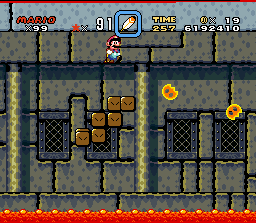
With this knowledge, the player is going to have to guess where these new, dangerous fireballs will bounce, and at what angle. It�s not a test of reflexes, but one of prediction. Fortunately, the fireballs aren�t very fast�although that doesn�t help much when they�re being reflected back and forth between ceiling and platform every second.
One interesting note, much like the falling spikes which will succeed them, the fireballs in this section are not cued by the position of the caterpillar platform. Rather, they are cued by Mario crossing an invisible line. This means that the fireballs can come at meaningfully different times, depending on where Mario is on the platform. The third fireball, in particular, can be reflected off the bottom of the caterpillar platform if Mario is further back on it when he hits the fireball�s trigger point. It�s not a game-breaking flaw, but it does leave one to wonder what the designers had in mind about the player�s probable position.
The caterpillar ride ends with a sequence of falling spikes that are complicated by a damaging ceiling and floor. Players who have not been through Vanilla Fortress (a secret level) may not be aware of the falling spike. Whether by coincidence or design, the designers reduced the penalty in this area so that being knocked off the platform�or panicking and falling�would not necessarily be fatal. Mario can still hop back on the platform, although it won�t be very easy.
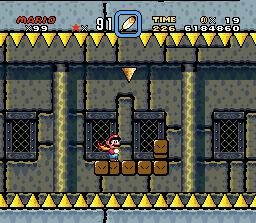
After the initial surprise is gone, these falling spikes aren�t altogether so different from Thwomps that the player can�t rely on old skills. One complication that we mentioned earlier, though, is that during certain points in the platform�s path, the ceiling can be close by. Accordingly, the player has to rely on controlled-height jumps, so Mario doesn�t end up in the ceiling spikes, either. Because of all these changes, this section is essentially an inter-level evolution, combining two well-known types of challenge (a moving platform, falling objects) into a single event that requires a skill new to this theme: the controlled-height jump.
Finally, the level closes with a changeover to a kind of moving target not seen for some time: the contracting platform. The basic timed jumps for the contracting platforms are quite simple�indeed, they�re from the very beginning of the game. The difficulty comes from the multiple bouncing fireballs which can easily hurt Mario while he�s jumping, knocking him into the fatal d-distance. Because of these one might even call this a crossover challenge since the real danger is the periodic fireballs bouncing around the room. Even beyond that, there are some periodic lateral fireballs coming out of Bowser statues.
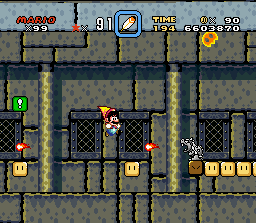
(These fireballs come at regular intervals, placing them in the periodic enemies theme.) The mix takes the challenge we last saw in Yoshi�s Island 3 and makes it quite a bit more challenging. The level ends with another stock moving-target boss, albeit with a few token upgrades. Like the next level in the moving targets theme (Chocolate Island 3), the challenges in Roy�s Castle really illustrate how much the player has learned and developed over the course of the game. Simple things like moving and contracting platforms have been reimagined in increasingly complex ways.
CHOCOLATE ISLAND 3
Chocolate Island 3 is perhaps the easiest level to explain in the game. The reason for this ease is that it does two very simple things throughout: expansion and evolution. This level is qualitatively very similar to Donut Plains 3; the resemblance is plain in the rotating platforms. Chocolate Island�s no longer have three arms, and that�s not the only change.
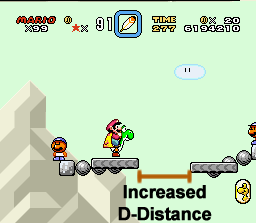
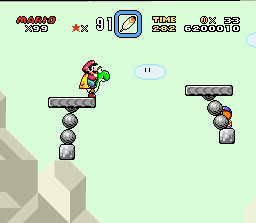
The differences are clear immediately: Chocolate Island�s platforms are much further apart, on average. Specifically, the average d-distance in Donut Plains 3 is 0.9 coin-blocks�which obviously isn�t a real length, but is a real average since so many of the d-distances are zero. The average d-distance in Chocolate Island 3 is about 2.1 coin-blocks. That doesn�t sound like a huge difference, but one block length matters a lot�especially when the target is moving. To better contextualize this, let�s look at the larger jumps. In Chocolate Island 3, there are six jumps with a d-distance of 4 or greater. In Donut Plains 3, there are none that large. So essentially, the standard challenges for each level are the same, but the expansions for Chocolate Island are much larger. It�s a plain and simple numerical upgrade; this doesn�t happen often in the game, but it�s definitely happening here.
This is to say nothing of the evolution which has swept through the entire level. Every platform hub is now the site of a patrolling periodic enemy that makes the jumps a little bit more difficult. This is just another form of restricting the player�s use of the cape-glide. If the player misses the platform jump, they might glide onto the hub block, but they�re going to have to bounce off the enemy and then stick the landing all over again. It�s not terribly hard, but it is more challenging than if it were merely an empty block. This is a very basic inter-level evolution, where something the player has seen many times before has a new element added to make it more complex.

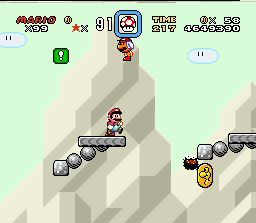
Halfway through the level there�s a mutation that exchanges all the Koopas for Fuzzies. These new enemies cover a little bit more ground by circling the hubs, and must be avoided rather than defeated. This shortens the window for the timing jump a little bit, but it�s not really that much of a change, especially if the player is using Yoshi. The whole point of this, in the end, is that small evolutions and expansions count for a lot. It�s easy for amateur designers to feel that their challenges don�t �look� sufficiently harder, and so they increase them to what appears correct. But changes that look small can feel big to the player, and that�s what matters.
CHOCOLATE ISLAND 4
Chocolate Island 4 forces the player to fight Mario�s momentum in a way that is unusual for this game, but fairly typical for previous Mario titles. Additionally�and unusually�it does so in the moving targets theme rather than the preservation of momentum or intercepts themes, where such action is more common. In doing this, the level reclaims some of the literal pitfalls of previous SMB titles. Mario�s ability to stop suddenly and fully shift his momentum is much greater in Super Mario World than it was in any of the previous major SMB titles. By this time in the game, even veterans of the series would have acclimated to the change in game-physics. The slanted platform changes this: because of the slope, Mario can easily fall off this platform while trying to land.
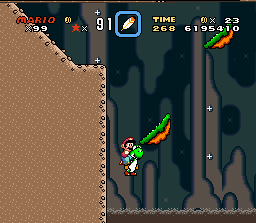
The �sticky� quality of sharp turns still exists, but because of the tendency to fall off one of these platforms, the player can�t always focus on the next moving platform. So, in a sense, this level takes the center of the moving targets theme�precision and timing�and throws a wrench in it by turning the platforms sideways.
This idea doesn�t progress very far, possibly because the player can easily catch on and neutralize the disadvantage, especially by landing on the middle and with as little momentum as possible. The standard challenge is, naturally, the first slanted platform. After that the player gets the chance to jump from one slanted platform to another, although there�s a platform �safety net� beneath.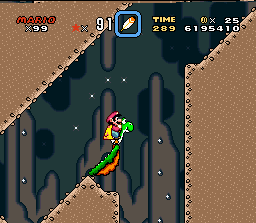
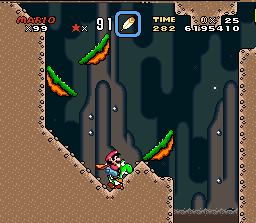
From there, the level�s biggest challenge is a large sea of these platforms. The key expansion lies in the two distances that have grown. First, the sea itself is one large pit and so has extended the underlying d-distance (earlier it was 4, now it�s greater than 15). The individual d-distances between platforms aren�t really larger, but now the height between them is greater.
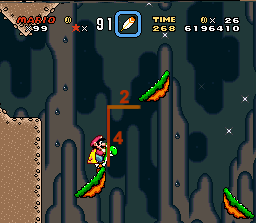
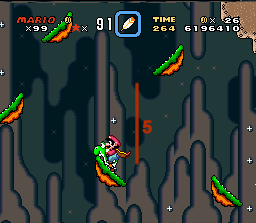
But, again, this is really all of the meaningful development that this idea sees. It�s a passably distracting break from the standard elements of this skill theme, although it probably could have endured more development, perhaps with some periodic enemies.
The last part of the level worth mentioning for the study of moving targets is the section which contains these three Mega Moles.
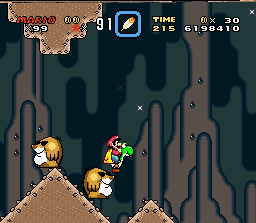
It�s really a shame that this enemy saw so little development as a platform. Although Valley of Bowser 1 develops the Mega Mole in tunnel combat, their use as possible platforms seems like it could have been greater. (This seems to have been the genesis for the Chomp Rock and Poochy in Yoshi�s Island.)
VALLEY OF BOWSER 3
Valley of Bowser 3 ups the ante in a peculiar way, by adding an expiration timer to its platforms. The level is clearly within the moving targets theme, because it�s overflowing with moving targets. These timed platforms are new, and they don�t appear anywhere else in the game. Other than that, though, they�re very clearly moving targets. On the left, below you can see the standard challenge�almost a training-wheels challenge in the way it has an unlikely penalty. That�s good, though, since these platforms are brand new and there�s no reason to test the player�s attention immediately.
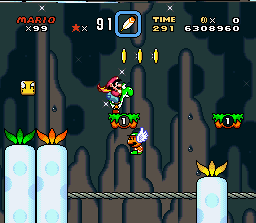
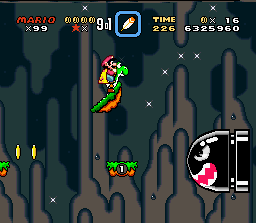
Pictured on the right are a couple of A-to-A evolutions that look like challenges introduced elsewhere in the game, but with timer platforms inserted. Although those are fairly bog-standard, there are some unusual things that keep it interesting. One of those interesting things is a very telling failure, in which the designers try to introduce an accumulation into the theme and don�t succeed at all. These slanted platforms exhibit the exact problem mentioned in the intro to this theme: they�re not an accumulation but merely an alternative.
Instead of a periodic enemies crossover, elements from the intercepts theme enter the level. These Banzai Bills were more or less a non-threat when we last saw them in Yoshi�s Island 2. Ninety percent of the game later, though, they seem quite a bit different, making these necessary platform-to-platform jumps more complicated.

This is a great example of how any single element in a videogame can be totally changed by context. The Banzai Bill is an easy enemy with a large hitbox; it�s very easy to bounce off in a large arc. This is a problem in Valley of Bowser 3, however, because the platforms here only have a 2-block surface area. That large arc can easily put Mario somewhere he can�t get out of, even with a cape glide. You can see above how, in the second situation, that one small moving platform is the only viable surface after the necessary jump. It�s not a pinnacle-level challenge (like some of the ones coming up soon), but it�s still tricky because the player will react to the big intercept with a gleeful enemy-bounce, and find that the only platform in sight is not where he or she would like it to be.
All in all, the apparent purpose of Valley of Bowser 3 is to sneak in an easy, open level before the onslaught of challenges to come in Castle #7 and Bowser�s Castle (or through the Valley Fortress, if the player goes that way). Like the levels to come, it mixes themes in a new and challenging way, and even adds a new kind of evolved moving target, but it�s still a relative relief to play after some of the puzzle-based and/or slow levels around it.
STAR WORLD 4
Star World 4 is the closest to what we might call "normal" of the Star Road levels, in that it fits neatly into a skill theme and progresses in a mostly normal way. Unlike Star World 2 it actually does have the kind of variety common to most levels, and unlike Star World 5 it doesn't have a vast free-form section in the middle that makes progression less comprehensible. Star World 4 does do something odd, however: it features two different (but thematically linked) standard challenges. This is not the only level which does this, but it isn't a common occurrence. Most of the levels which involve two standard challenges are long enough that both challenges can develop fully, or close enough to it. Star World 4 isn't long enough to do that, and so the two standard challenges are rather abbreviated. In this sense, Star World 4 fits in with the length of the other Star Road levels which are all rather short and lack common elaborative touches.
The first standard challenge has Mario jumping from a moving platform onto a stationary platform on which a Koopa is patrolling. The moving platform is a moving target, and the patrolling Koopa (because of the platform edges) is a periodic enemy. Now, in other circumstances this enemy would have been an intercept, but here it�s a periodic enemy because the player can see the entire platform before jumping. Instead of having to react, the player has to plan, and that�s definitely a skill in the moving targets (rather than intercepts) skill theme.
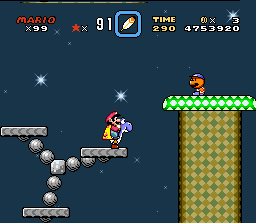
This challenge actually doesn't evolve or expand much until the end of the level, but it may not really need to. Of all the levels in the moving targets theme, this level has the second-highest average delta height (2.7) and d-distance (3.1). Those numbers aren't anything to write home about in and of themselves, but they do show that the gaps between jumps are bigger here than any other level except one. (Note that the level with the highest d-distance is actually Castle #2, which shows that the levels with the most difficult �numbers� don�t come late in the game like you would necessarily expect.) This is a kind of consolation that exchanges raw distance for development, since the Star Road levels are short.
There are only two instances of significant development of this standard challenge. The first is pictured just below.
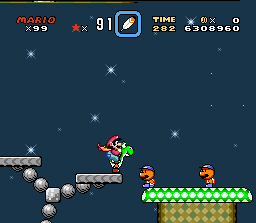
This is an obvious expansion of the standard challenge that doubles the number of periodic enemies on the platform. There is one more expansion which caps the development of this idea, later in the level. This expansion takes the alternate route; instead of increasing the number of Koopas it contracts the width of the platform.
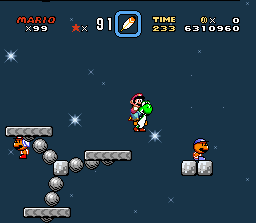
The idea behind both of these challenges is that the player has to choose the appropriate window of time to jump from the moving platform onto the moving enemy (or around it). As the number of enemies goes up or the platform size decreases, it becomes a little trickier to find the right moment before either the platform or enemy winds up at an inconvenient position.
The other challenge in the level which sees regular (if limited) development is an unusual wall of Wing Koopas. Almost every challenge which isn't either in water or in a castle involves jumping over something. This is one of the rare examples of a non-castle challenge where the player is much better off jumping under it.
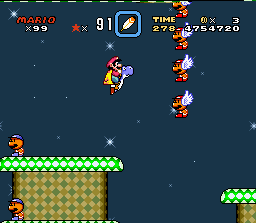
With a cape-glide or by knocking out the bottom Koopa, this isn't too hard a jump. At the apex of their patrol, the Wing Koopas allow eight blocks of height for Mario to choose his arc to the next platform. Later in the level this is reduced as one might expect.
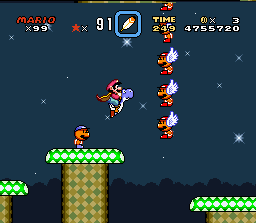
For this challenge, the peak height of the Wing Koopas is reduced to six blocks above Mario's feet. This isn't the most difficult controlled-height jump in the game by a long shot, but because of the d-distance involved, the player will have to peak Mario's arc before the wall of Koopas, or else take the time to eliminate them all with action techniques.
There is a fairly original take on moving targets challenges in the level which doesn�t develop. This challenge involves putting Wing Koopa patrol paths right inside the radius of a rotating platform. It happens twice (the first time is in the contraction above), but it doesn�t really go anywhere.
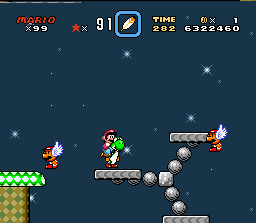
It might have been pretty easy to add more enemies like this, or complicate the shape, but the level never goes through with it, which is unfortunate. This is one of the rare instances in which accumulation might have been concretely possible.
Although there are two entirely different challenges which see development in Star World 4, that development is fairly minor. The two standard challenges also cohere well because the first is in the moving targets theme while the second is clearly in the periodic enemies theme (patrolling Wing Koopas are just that�a patrol). So while this is an unusual level, it's only because it uses established patterns in a weird way, rather than breaking them altogether.
WAY COOL
Way Cool is definitely the most difficult level in the theme, although it�s hard to say if it qualifies as the pinnacle since it doesn�t properly include an accumulation, as the other pinnacle levels in other themes do. What makes Way Cool interesting is how well it fuses the two sides of the genre declension, giving us the best example of something this theme does a lot of. Although the principle skill is definitely the timing jump, there are quite a few periodic enemies to be found everywhere in the level. These enemies are set in a great variety of challenging loops, sometimes by shape and sometimes sheer density. This is the standard challenge:
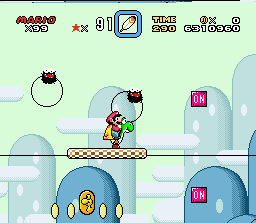
From here, the Fuzzies will only become more challenging for a variety of reasons.
One important difference from Cheese Bridge the player will notice is that the moving platform is actually 4 blocks wide, rather than the three-block platform from that level. In fact, the vast majority of moving platforms have been three blocks wide. The reason this one is four blocks wide is that the player is going to need that extra step. Many of the periodic enemy traps in this level feature two Fuzzies that are pathed in such a way that the jump window is either miniscule or requires a very tall jump, depending on the point the jump is taken. For example, here�s an obvious expansion/evolution of the standard challenge.
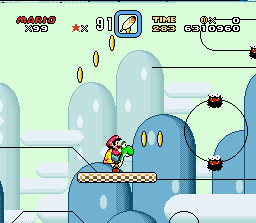
By allowing Mario to back up an extra block length on the moving platform, the designers extended the window of opportunity for making that jump. Additionally, the added width can allow Mario to jump from one side of the platform to the other, which would have been very tricky in other levels.
As one might expect, the designers used inter-level evolutions here too: the on/off switches of Donut Plains 3 are mixed in to devious effect. There is a single ideal path in this level which will lead to the acquisition of Yoshi and an early exit. The player would need quite a bit of good luck finding that path on their first try, however, because the switches are very counterintuitive. The high road, typically the domain of secrets in Mario games, is actually a giant trap that leads the player back to the beginning. There are several other dead-ends which will result in a disappointingly inexorable death, too. There are also some odd enemy path shapes, and when the saws show up in this level they aren�t telegraphed nearly as far in advance as they are in Cheese Bridge.

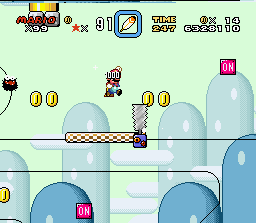
Many of these jumps require very precise timing and a short, quick jump-arc, but none of the jumps goes very far, and no jump ever requires bypassing more than two enemies. This is a big contrast from Valley Fortress or Tubular, where the same challenges just grow ominously larger and larger. The designers really deserve credit for creating challenges with small quirky innovations where expansion might have been easier.
Much like it was in Cheese Bridge, the second half of this level might ordinarily fit into the periodic enemies theme; it certainly uses a lot of them. I think the designers did a nice job straddling the middle of the composite, however, by including a lot of interesting jumps and alternate paths through the level that mix up the challenges. It�s possible to survive most of the tracked content�like the standard challenge and its evolution/expansions, below�by going only up and down the rope.
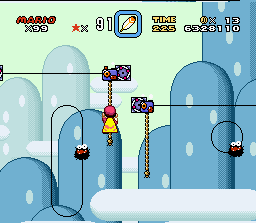
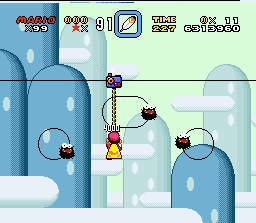
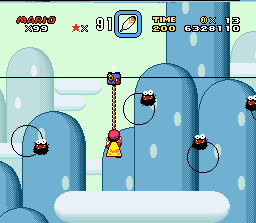
In fact, this would have made for excellent training for Tubular had it come beforehand, since it involves the same essential skill: vertical movement and lots of very precise prediction. The player will probably have to do this section more than once because the path is jam-packed with enemies. But nothing really prepares the player for Tubular, and in the end this wasn�t meant to do so, either. Well-timed jumps from the top of the rope are a viable strategy here�if not essential, considering that the player has never seen periodic enemies like these before. Jumping over the enemies here with a short cape-glide is exactly the strategy used earlier in the level to avoid the same circling enemy traps, so it�s no surprise that players might try it again and succeed.
LARRY'S CASTLE
The final castle features the only real accumulation in the moving targets theme, although this accumulation is small. This level also serves as a good example of why accumulations are few in this theme, and crossovers so frequent. The standard challenge for the level is remarkable amongst moving targets, especially this late in the game, because the penalty is only 1.
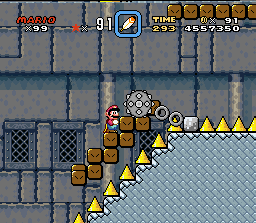
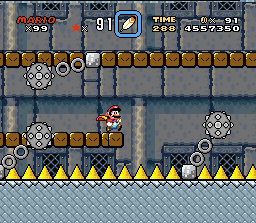
This challenge introduces the centerpiece of this level, an encounter between caterpillar platform and Ball'n'Chain. As the write-up of this theme has explained several times before, the moving targets theme declines frequently and deeply into the periodic enemies theme and this level is no exception. This section is crowded with periodic enemy movements, but what reinforces the moving targets theme is the fact that Mario is better of jumping than doing a timed run. Really, the player doesn�t have time to pause and run between all those Ball�n�Chains, because the caterpillar will simply leave him behind. Instead, the best course is to jump at the right moment and keep moving forward with the platform.
The standard challenge first expands, and then evolves. The most obvious change is the expansion that raises the penalty from one to two, moving from spikes to lava.
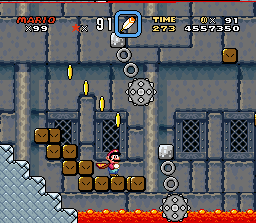
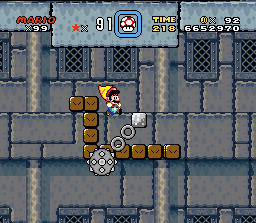
Later on there is an evolution/expansion when the platform begins tracking around the Ball�n�Chain in a tight square shape, a form which is not only qualitatively more complex but also a contraction which greatly reduces the safe space compared to earlier challenges. Neither of these are proper accumulations, however. The accumulation is actually quite brief and would be unremarkable except that it�s the only example in the theme.
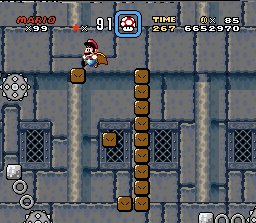
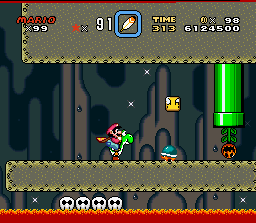
Here the level combines the caterpillar platform�s movement properties with an element from Vanilla Dome 3. In that earlier level, the player had to separate Mario from the platform while still staying close to it (pictured on the right, above). Here Mario has to do the same, at least in theory. It�s altogether too easy for the player to simply stand on the lead block of the caterpillar platform and ride it. That�s obviously not what�s intended here; what the designer wants the player to do is have to jump on the one-block platforms to keep up with the platform. This separation continues for a while afterwards, too.

If anything, the level gets easier in this part of the separation from the platform, as Mario�s ability to run freely is increased. Still though, the combination of separation and a caterpillar platform is the only real accumulation in the theme, and for one brief instant it was different and interesting. The designers could have done a lot more with it, but at least they found a way to use accumulation in this theme as they did in all the other themes.
The second half of the level is fully in the periodic enemies declension, but is not covered in that section because it doesn�t show much in the way of a cadence. All but one of these challenges is really just a mutation of the first one.
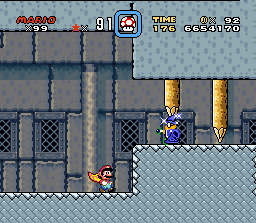
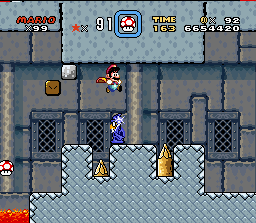
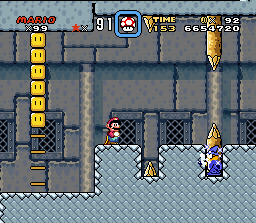
Although the spike configurations are different, none of them are palpably harder than any other. Magikoopa can appear anywhere, anytime, and so he presents an added difficulty, but he doesn�t get any harder or easier based on his positioning. This last bridge would constitute an evolution, but is still not altogether that hard.
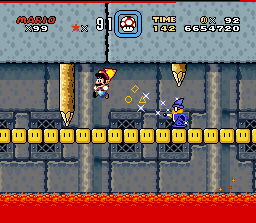
The threat posed by Magikoopa breaking the bridge is not that much greater than in any previous challenge, since it�s easy enough to lead his shots away. It is an evolution, but being the only one it hardly constitutes a proper cadence.